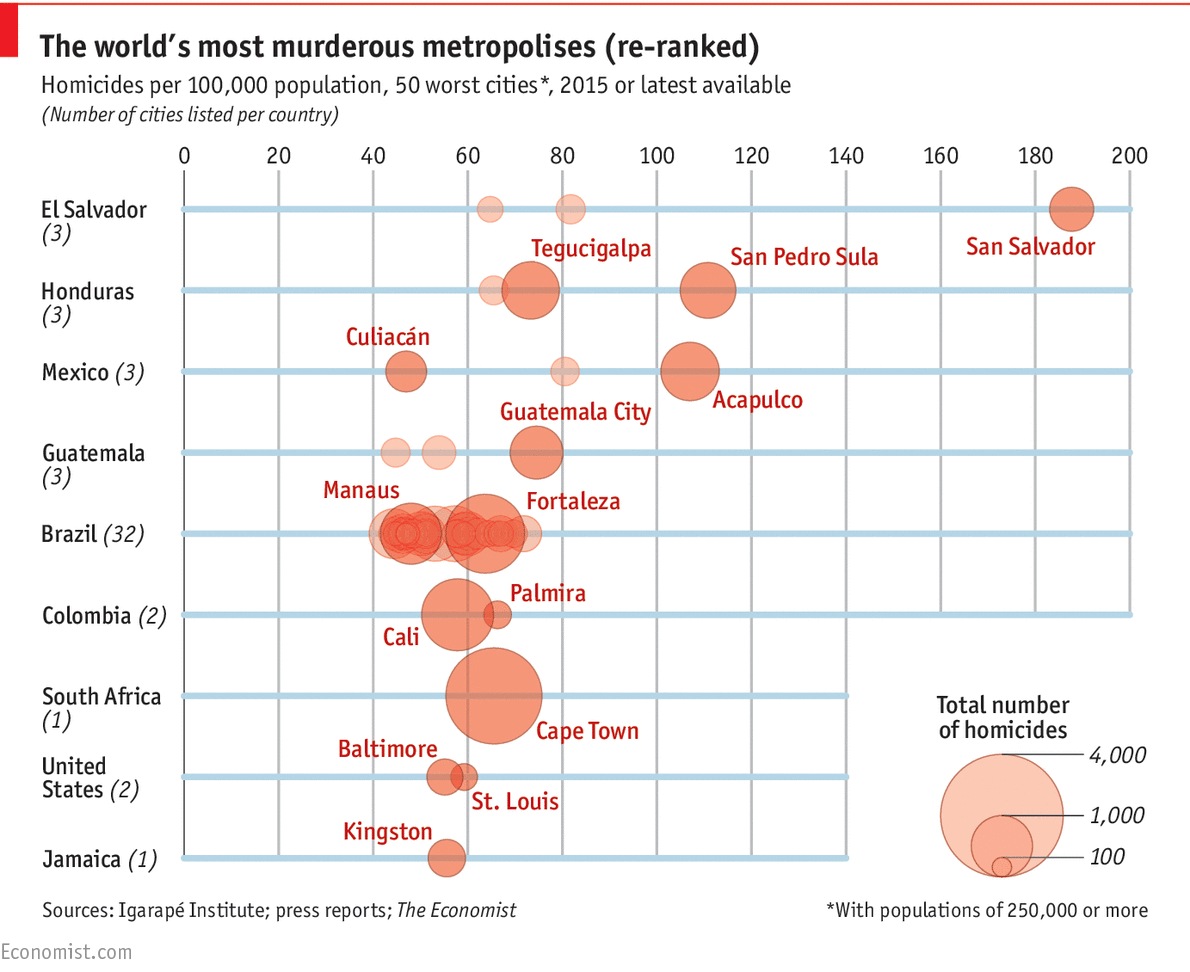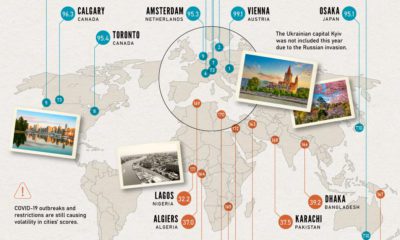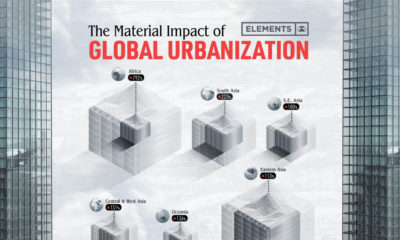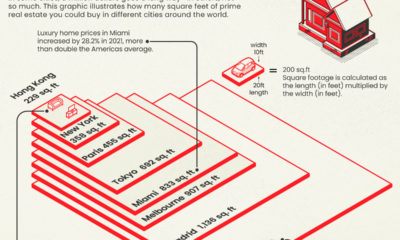The Most Violent Cities in the World
Brazil has been in crisis for some time now. The country’s economy shrunk -3.8% last year, and its President, Dilma Rousseff, is holding on for dear life. Once chairman of Petrobras, the state-run oil giant currently engulfed in a colossal political scandal, she is now being threatened with impeachment just 15 months into her second four-year yerm. Her approval remains at an all-time low of just 11%. The currency has halved in value since 2011, and the country’s credit has been downgraded to junk status. However, it’s not only the economic and political spheres that are troubling in Brazil. The country also has the dubious distinction of being the world center for homicides. Today’s chart, from The Economist, shows the 50 most murderous cities in the world – and Brazil is home to a mind-boggling 32 of them. The good news is that key cities, such as Rio de Janeiro, are on the lower side of the spectrum. That said, the host of the 2016 Olympic Games is barely safer than Compton, with a murder rate of 18.6 per 100,000 people each year. The bad news is that Brazil now has more than 10% of all the world’s murders. While the murder rate has fallen in the largest cities around the country, it has picked up in many of the smaller ones. Cities such as Fortaleza or Natal are among the most violent in the world, with rates above 60 murders per 100,000.
Other Notes on the Study
The United States made the list with two of the 50 most violent cities: Baltimore and St. Louis. Latin America was home to 44 of 50 of the cities. The only cities not in Latin America: Baltimore, St. Louis, Kingston (Jamaica), and Cape Town (South Africa). Venezuela was omitted from these rankings because of highly inaccurate data, but Caracas and other cities in the country are known to be some of the most dangerous cities in the world.
on Even while political regimes across these countries have changed over time, they’ve largely followed a few different types of governance. Today, every country can ultimately be classified into just nine broad forms of government systems. This map by Truman Du uses information from Wikipedia to map the government systems that rule the world today.
Countries By Type of Government
It’s important to note that this map charts government systems according to each country’s legal framework. Many countries have constitutions stating their de jure or legally recognized system of government, but their de facto or realized form of governance may be quite different. Here is a list of the stated government system of UN member states and observers as of January 2023: Let’s take a closer look at some of these systems.
Monarchies
Brought back into the spotlight after the death of Queen Elizabeth II of England in September 2022, this form of government has a single ruler. They carry titles from king and queen to sultan or emperor, and their government systems can be further divided into three modern types: constitutional, semi-constitutional, and absolute. A constitutional monarchy sees the monarch act as head of state within the parameters of a constitution, giving them little to no real power. For example, King Charles III is the head of 15 Commonwealth nations including Canada and Australia. However, each has their own head of government. On the other hand, a semi-constitutional monarchy lets the monarch or ruling royal family retain substantial political powers, as is the case in Jordan and Morocco. However, their monarchs still rule the country according to a democratic constitution and in concert with other institutions. Finally, an absolute monarchy is most like the monarchies of old, where the ruler has full power over governance, with modern examples including Saudi Arabia and Vatican City.
Republics
Unlike monarchies, the people hold the power in a republic government system, directly electing representatives to form government. Again, there are multiple types of modern republic governments: presidential, semi-presidential, and parliamentary. The presidential republic could be considered a direct progression from monarchies. This system has a strong and independent chief executive with extensive powers when it comes to domestic affairs and foreign policy. An example of this is the United States, where the President is both the head of state and the head of government. In a semi-presidential republic, the president is the head of state and has some executive powers that are independent of the legislature. However, the prime minister (or chancellor or equivalent title) is the head of government, responsible to the legislature along with the cabinet. Russia is a classic example of this type of government. The last type of republic system is parliamentary. In this system, the president is a figurehead, while the head of government holds real power and is validated by and accountable to the parliament. This type of system can be seen in Germany, Italy, and India and is akin to constitutional monarchies. It’s also important to point out that some parliamentary republic systems operate slightly differently. For example in South Africa, the president is both the head of state and government, but is elected directly by the legislature. This leaves them (and their ministries) potentially subject to parliamentary confidence.
One-Party State
Many of the systems above involve multiple political parties vying to rule and govern their respective countries. In a one-party state, also called a single-party state or single-party system, only one political party has the right to form government. All other political parties are either outlawed or only allowed limited participation in elections. In this system, a country’s head of state and head of government can be executive or ceremonial but political power is constitutionally linked to a single political movement. China is the most well-known example of this government system, with the General Secretary of the Communist Party of China ruling as the de facto leader since 1989.
Provisional
The final form of government is a provisional government formed as an interim or transitional government. In this system, an emergency governmental body is created to manage political transitions after the collapse of a government, or when a new state is formed. Often these evolve into fully constitutionalized systems, but sometimes they hold power for longer than expected. Some examples of countries that are considered provisional include Libya, Burkina Faso, and Chad.














